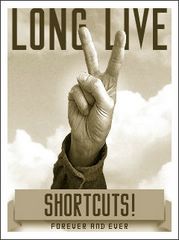It's open season on research-based writing for college classes. The secret to writing correct bibliographic entries is to use a reference book such as Diane Hacker's A Writer's Reference (5th ed., with 2003 MLA update) or the MLA Handbook for Writers of Research Papers (Joseph Gibaldi, 6th ed.) and find the appropriate model or models for the source you are using. Sometimes you must combine elements from a couple of models.
Here are four MLA bibliographic citations that cover the sources most students use in their research papers: the scholarly article accessed via a database, the document from a government web site, the webpage from a larger web site, and a short work from an anthology.
Scholarly Article Accessed Via a DatabaseIf you are using Hacker's A Writer's Reference as your guide, then you will wish to follow model no. 31 (360). To write this citation, you provide all the information that's available for the print version of the article, and then you add the necessary information about how you accessed it online. Example:
Koumans, Emilia H., et al. "Sexually Transmitted Disease Services at US Colleges and Universities." Journal of American College Health 53.5 (2005): 211-217. Academic Search Premier. EBSCOhost. Hinckley Lib., Northwest Col., Powell, WY. 31 Mar. 2005 ‹http://www.epnet.com›.
Within the body of your paper, you would use the following intext citation: (Koumans et al. 212).
Document from a Government Web SiteWhen a webpage comes from a government-sponsored web site--such as the CDC--then you need to identify the government as the "corporate author" of the document. You would use Hacker's model at the top of page 366, the second example for no. 49. Example:
United States. National Center for HIV, STD and TB Prevention. Centers for Disease Control and Prevention. HIV and Its Transmission. 22 Sep. 2003. 31 Mar. 2005 ‹http://www.cdc.gov/hiv/pubs/ facts/transmission.htm›.
The intext citation for this source would be (United States); for subsequent citations, you could use an abbreviation (US). If you had more than one document from this same web site, then you need to add more information so readers can find the citation easily in your Works Cited list: (United States, HIV).
Webpage from a Larger Web SiteThe model for a webpage (or a short work) from a larger web site is no. 28 in Hacker (358). Here's an example for a webpage without an author:
"HIV/AIDS: Antiretroviral Therapy (ART)." World Health Organization. 2005. 31 Mar. 2005 ‹http://www.who.int/hiv/topics/arv/en/›.
The appropriate intext citation for this webpage would be ("HIV/AIDS").
A Chapter or Section or Short Work from a Book/AnthologyThe model for a work in an anthology is no. 10 in Hacker (352). Here's an example for a short story from an anthology:
Faulkner, William. "A Rose for Emily." Literature: Approaches to Fiction, Poetry, and Drama. Ed. Robert DiYanni. Boston: McGraw-Hill, 2004. 73-79.
The appropriate intext citation for this webpage would be (Faulkner 74).
Remember: When in doubt, contact your professor for guidance.
 Secrets of the Dead is a fascinating program on the subject from PBS. The show presents the work of Dr. Stephen O'Brien of the National Institutes of Health in Washington D.C. His work took him to Eyam, a small village in central England, where records showed that during the plague years over half the population survived an infestation which should have wiped them out.
Secrets of the Dead is a fascinating program on the subject from PBS. The show presents the work of Dr. Stephen O'Brien of the National Institutes of Health in Washington D.C. His work took him to Eyam, a small village in central England, where records showed that during the plague years over half the population survived an infestation which should have wiped them out.


 It was a rootin', tootin' evening when Paul Zarzyski brought his brand of cowboy and western poetry to the Nelson auditorium.
It was a rootin', tootin' evening when Paul Zarzyski brought his brand of cowboy and western poetry to the Nelson auditorium.

 The Northwest College Writers Series and the NWC Rodeo Team are joining forces to sponser nationally acclaimed poet Paul Zarzyski on Saturday, Oct. 15, at 7:30 p.m. in the Nelson Performing Arts Center Auditorium.
The Northwest College Writers Series and the NWC Rodeo Team are joining forces to sponser nationally acclaimed poet Paul Zarzyski on Saturday, Oct. 15, at 7:30 p.m. in the Nelson Performing Arts Center Auditorium. First Friday, the Humanities Division's open microphone poetry and prose reading, returns on October 7th at noon in the Hinckley Library.
First Friday, the Humanities Division's open microphone poetry and prose reading, returns on October 7th at noon in the Hinckley Library.  Completing the top ten are
Completing the top ten are 




 ms.dsk is reading
ms.dsk is reading  Rob Koelling is reading
Rob Koelling is reading  S. Renee Dechert is reading
S. Renee Dechert is reading  Mary Ellen Ibarra-Robinson is reading
Mary Ellen Ibarra-Robinson is reading  Bill Hoagland is reading
Bill Hoagland is reading  Jennifer Sheridan is reading
Jennifer Sheridan is reading  Robyn Glasscock is reading poetry by
Robyn Glasscock is reading poetry by  Susan Watkins is reading
Susan Watkins is reading